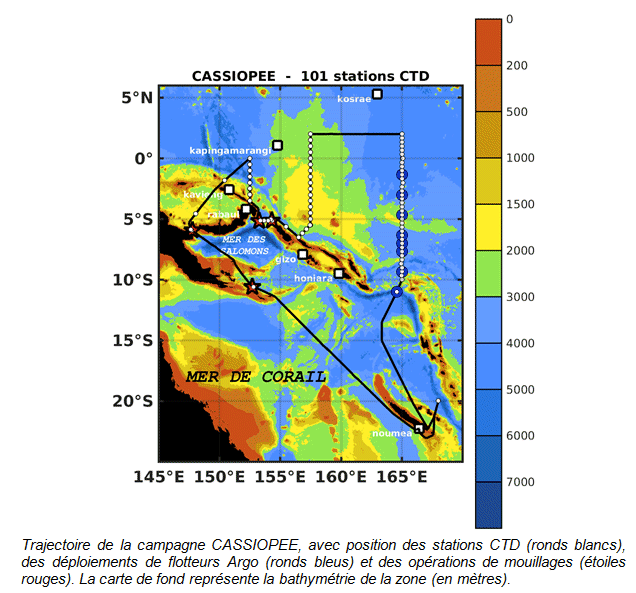Background and scientific objectives:
At depths of 1000 and 1500 meters in the equatorial Pacific Ocean, the presence of alternating zonal jets could be demonstrated at the basin scale from the analysis of Argo float drift (Cravatte et al. 2012). The main objectives of the CASSIOPEE cruise (Figure 1) were to describe the 3D structure of these zonal jets in the western tropical Pacific, from the thermocline to the ocean floor; to understand the properties of the water masses they carry and the associated mixing; and their connection with the Western Boundary currents. The CASSIOPEE cruise was the in situ component of the LEFE ZEBRE project (PI: Sophie Cravatte), whose main goal was to better understand the characteristics of these extra-equatorial deep jets in the Pacific and other tropical oceans.
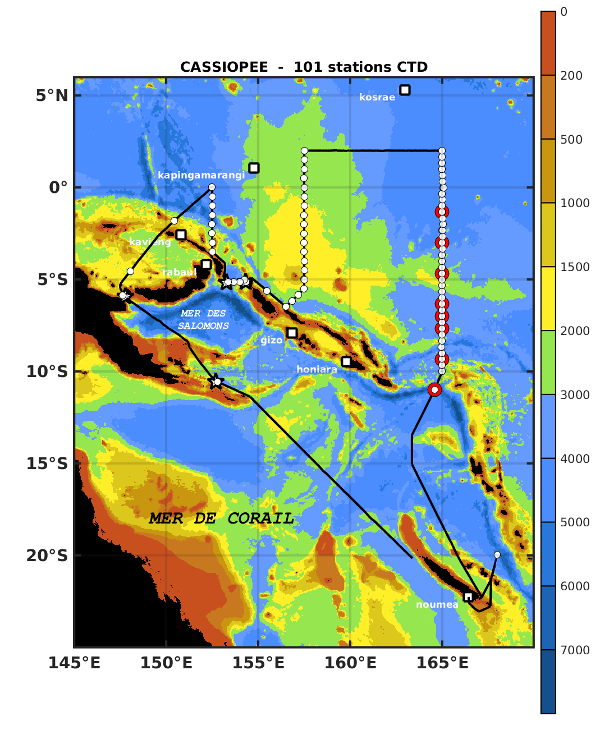
Figure 1: Map of the CASSIOPEE cruise: cruise trajectory (black line), position of CTD stations (white dots) and position of subsurface float releases (red dots).
Main results:
1- Vertical structure of zonal currents
Cravatte S., Kestenare, E., Marin, F., Dutrieux, P., Firing, E. (2017). Subthermocline and Intermediate Zonal Currents in the Tropical Pacific Ocean: paths and vertical structure. Journal Of Physical Oceanography, 47(9), 2305-2324. https://doi.org/10.1175/JPO-D-17-0043.1
The vertical structure of the jets was studied from a historical compilation of S-ADCP current measurements, including data from the CASSIOPEE cruise, and Argo float data (Figure 2). This compilation provided for the first time a global, fine-scale view of the 3D structure of zonal currents in the Tropical Pacific.
The alternating zonal jets observed at 1000m jets are far from being barotropic, and the observations revealed the existence of 2 systems of jets (Figure 2):
- the "multiple Tsuchiya jets", observed between the thermocline and 700-800m
- the extra-equatorial intermediate currents (LLICs) below 800m.
During CASSIOPEE, the different zonal jets were well observed, with amplitudes and positions similar to the climatological values observed with the Argo floats (Figure 3).
These two systems have different characteristics (the Tsuchiya multiple jets shift poleward from west to east, whileLLICs have a tendency to tilt toward the equator from west to east), which suggests that these jets are dynamically distinct, with different forcing mechanisms, and are therefore different dynamical objects. These observations question the validity of some theories proposed to explain the existence of these jets.
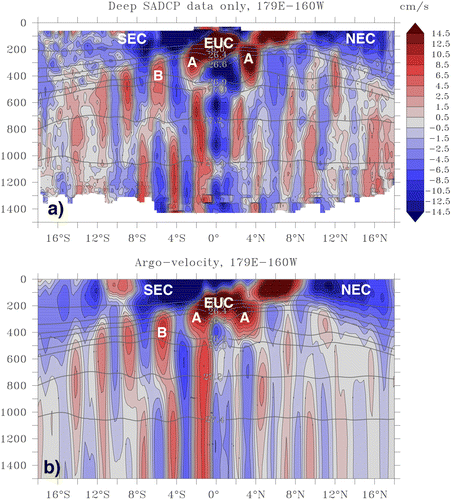
Figure 2: Latitude-depth distribution of zonal velocity in the equatorial Pacific in the 179°E-160°W box from a gridded product of historical S-ADCP (top) and geostrophic velocity (bottom) data, after Cravatte et al. (2017). Some currents are mentioned: EUC (Equatorial UnderCurrent), SEC (South Equatorial Current), NEC (North Equatorial Current), A (primary Tsuchiya Jets), B (secondary Tsuchiya Jets)
2- Hydrological properties and transport of zonal currents from West to East.
Delpech, A., Cravatte, S., Marin, F., Morel, Y., Gronchi, E., Kestenare, E. (2020). Observed tracer fields structuring by mid-depth zonal jets in the tropical Pacific. Journal Of Physical Oceanography, 50(2), 281-304. Publisher's official version : https://doi.org/10.1175/JPO-D-19-0132.1 , Open Access version : https://archimer.ifremer.fr/doc/00593/70490/
The CASSIOPEE cruise has provided a unique set of observations over the entire water column in the western equatorial Pacific to describe the meridional and vertical structure of these deep extra-equatorial jets. These data were analyzed during the thesis of A. Delpech's thesis (supervision F. Marin, S. Cravatte, Y. Morel). An unexpected result is that eastward jets are associated with oxygen fronts and potential vorticity, and westward jets with mixing and homogenization zones, indicating the role of isopycnal mixing in maintaining and strengthening the jets (Figure 3).
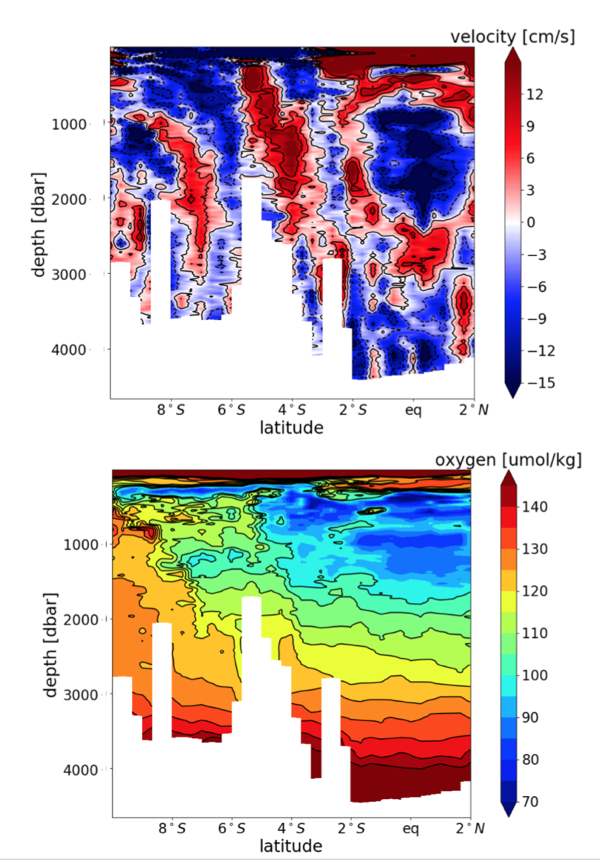
Figure 3: Latitude-depth distribution of zonal velocity measured by L-ADCP (top) and oxygen (bottom) along 165°E during the CASSIOPEE cruise (Delpech et al., 2020a)
Audrey showed that during the CASSIOPEE cruise, the Equatorial undercurrent and Tsuchiya jets were associated with positive (in the eastward jets) or negative (in the westward jets) oxygen anomalies, confirming that these eastward currents are indeed fed at these depths by oxygenated Solomon Sea waters. It also showed that the Equatorial Deep Jets (currents at the equator, alternating westward and eastward on the vertical) were also associated, down to 1500m, with positive oxygen anomalies (Figure 4).
However, deeper, the eastward jets of the LLICs system are associated with oxygen fronts, extending from 500 to 3000m depth, while the westward currents are associated with homogeneous oxygen zones; fronts are also observed in salinity and potential vorticity in the eastward jets. These surprising structures are also observed in the historical cross-equatorial WOCE and TAO surveys that Audrey subsequently analyzed; at all longitudes, regardless of time period, such alternating fronts/homogeneous zones are observed in oxygen (Figure 5).

Figure 4: (after Delpech et al., 2020a). Signature of EDJs in CASSIOPEE. Zonal velocity (black dashed lines) and oxygen anomalies (solid lines) from 300 to 2800 m averaged between 1°N and 1°S at longitudes 152.5°E (left), 157.5°E (middle) and 165°E (right). Data were filtered between 100 and 500 m.

Figure 5: (after Delpech et al., 2020a) Cruise data used. The blue lines represent WOCE sections; the black symbols represent the different TAO cruises. The pink box gives the detailed positions of the hydrological stations of the CASSIOPEE cruise.
These results have several major implications:
- Below the thermocline, eastward currents do act as a conveyor belt to ventilate areas of oxygen minimum located east of the basins. Positive oxygen anomalies are observed throughout the basin.
- Deeper, eastward jets do not visibly carry oxygen anomalies, but help structure the large-scale oxygen fields, participating in mixing.
- These meridional "staircase" structures are consistent with theories of formation and maintenance of zonal jets invoking homogenization by isopycnal turbulent mixing, and provide new insights into existing theories.
3- Particle transfer to the abyss
Kiko R., Biastoch A., Brandt P., Cravatte S., Hauss H., Hummels R., Kriest I., Marin Frederic, McDonnell A. M. P., Oschlies A., Picheral M., Schwarzkopf F. U., Thurnherr A. M., Stemmann L. (2017). Biological and physical influences on marine snowfall at the equator. Nature Geoscience, 10(11), 852-858. https://doi.org/10.1038/NGEO3042
During the CASSIOPEE campaign, UVP5 observations (imaging with a submerged camera attached to the rosette) provided evidence, along with other cross-equatorial measurements over different deep ocean campaigns, that the equatorial band represented a preferred pathway for vertical transfer of marine production to the abyss (Kiko et al., 2017). Columns of particles were observed between the surface and the ocean floor, several thousand kilometers apart in a band less than 500km wide around the equator. Physical processes related to the presence of deep zonal currents (SICC and NICC) play a key role in this distribution. They act as a barrier, and as a kind of privileged channel for the sedimentation of particles, thus preventing the dispersion outside the equator.
The deep eastward jets observed at 2°N and 2°S thus help to concentrate fine particles around the equator (Figure 6), and could contribute to modulate the transfer of particulate carbon from the surface to the deep ocean.
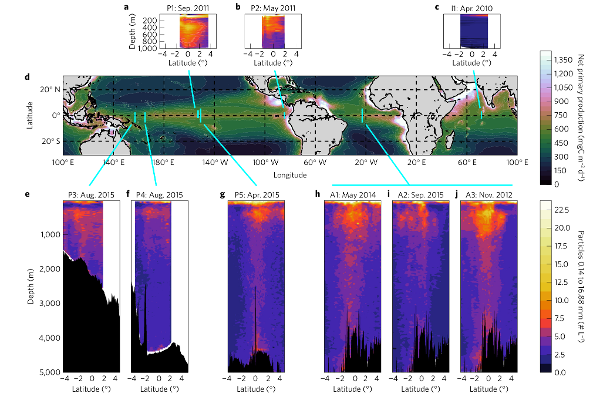
Figure 6: (a-c and e-j) latitude-depth distribution of particle abundance observed at various longitudes in the equatorial oceans between April 2010 and September 2015; (d) annual net average primary productivity derived from satellite observations (Kiko et al., 2017).
4- Geochemical enrichment of waters in the Western Equatorial Pacific
Behrens, M. K., Pahnke, K., Cravatte, S., Marin, F., Jeandel, C. (2020). Rare earth element input and transport in the near-surface zonal current system of the Tropical Western Pacific. Earth And Planetary Science Letters, 549, 116496 (11p.). https://doi.org/10.1016/j.epsl.2020.116496
Behrens, M. K., Pahnke, K., Delpech, A., Cravatte, S., Marin, F. , Jeandel, C. Seawater rare earth elements tracing elemental input and eastward transport in the thermocline to mid-depth zonal current system of the tropical Pacific, in preparation.

Figure 7 (from Behrens et al., 2020)
Melanie Behrens analyzed the geochemical samples from CASSIOPEE, and obtained a whole set of dissolved rare earth concentrations for the ocean surface layer. We collaborated with her and her team to interpret the results.
These data, combined with data on currents and their hydrological properties, allowed us to better quantify the continental sources and the surface water pathways from their contact with the ocean margin. Concentrations are higher in the equatorial eastward currents than in the westward currents. The results confirmed that the sediments of the Papua New Guinea coasts are an important source of chemical elements for the ocean.
Melanie then analyzed the samples at depth, taken in the heart of the eastward and westward jets. These results are still being interpreted, and a publication is in preparation.
5- deep circulation
Germineaud C., Cravatte S., Sprintall J., Alberty M.S., Grenier M., Ganachaud A. (2021). Deep pacific circulation: New insights on pathways through the Solomon Sea. Deep Sea Research Part I: Oceanographic Research Papers IN PRESS. https://doi.org/10.1016/j.dsr.2021.103510
Deep data from the CASSIOPEE campaign (hydrological and current data) were finally used, together with data from the PANDORA and MoorSPICE campaigns, to revisit the pathways and transformations of deep waters in the Pacific basin. Cyril Germineaud (post-doctoral fellow) has shown that the Solomon Sea is an exchange and mixing basin for deep circumpolar waters from the Coral Sea and the East Caroline Basin.
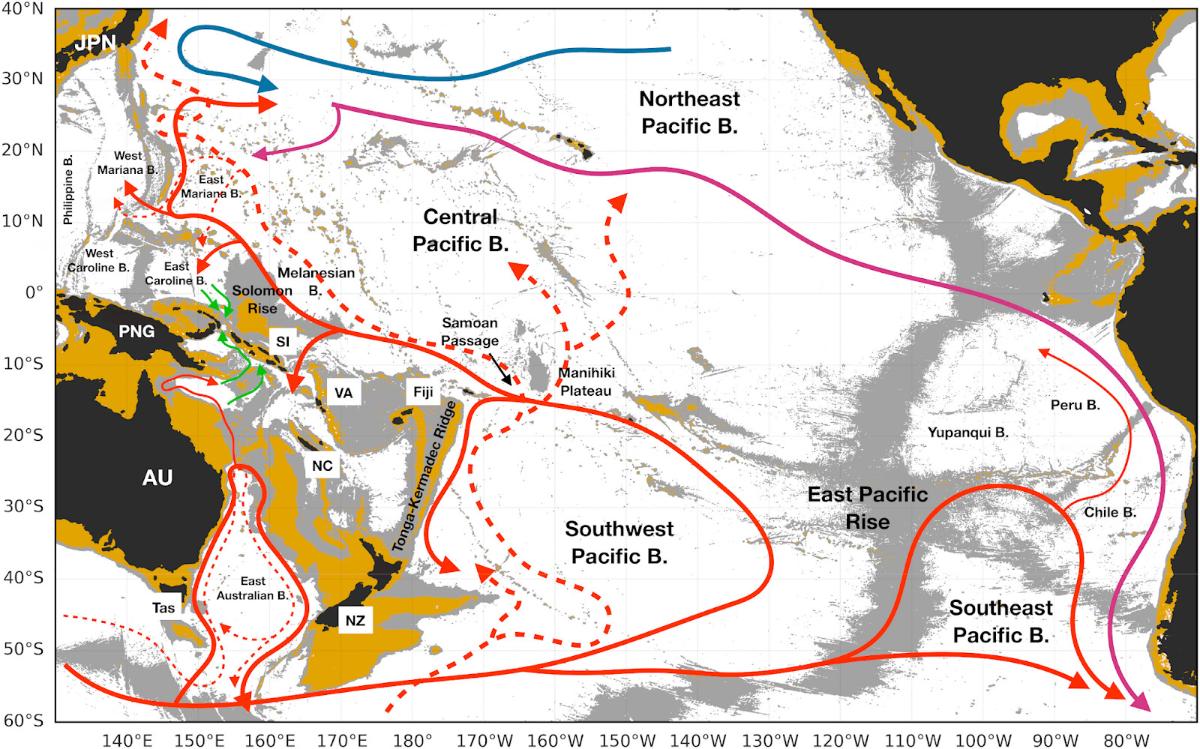
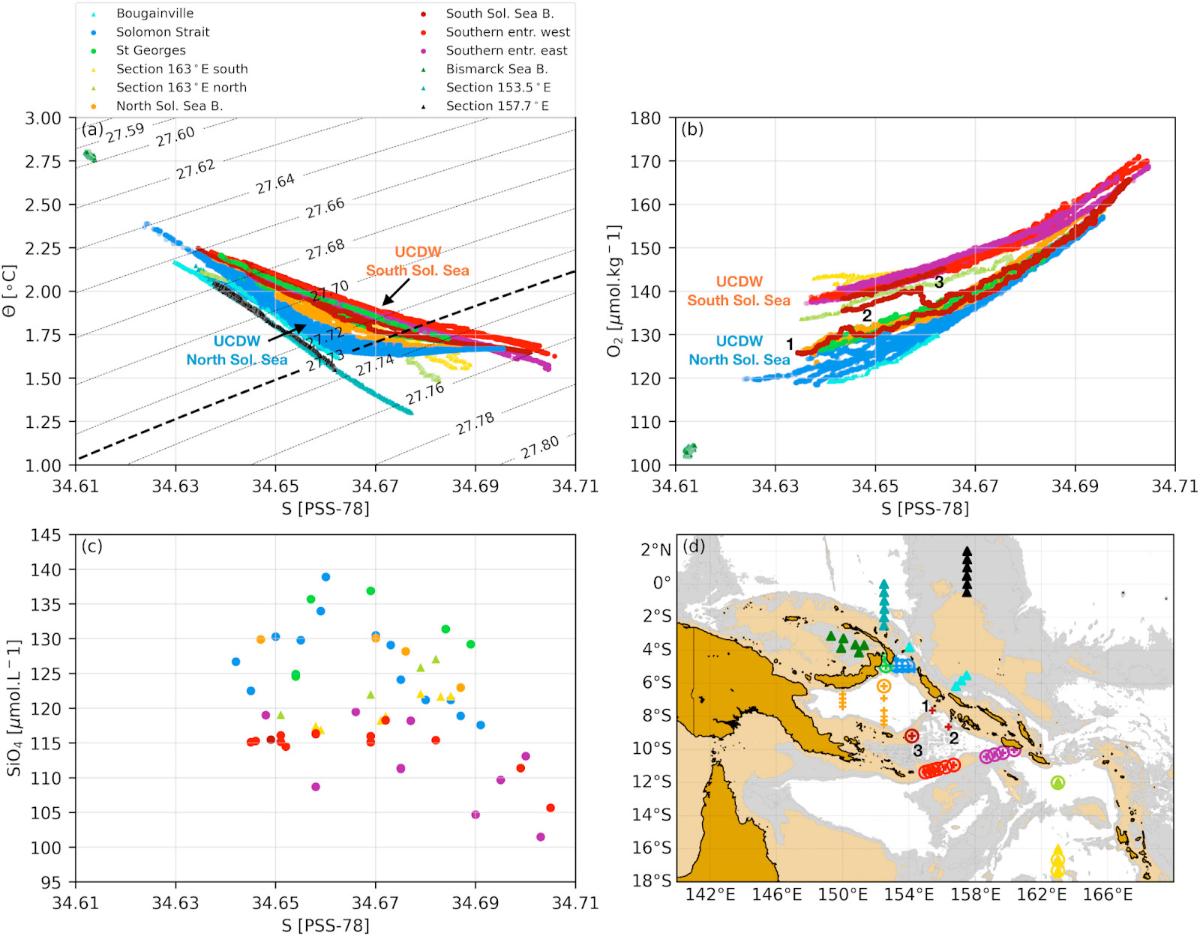
Figure 8 (after Germineaud et al., 2021): (top): Schematic of deep water circulation. Red: Upper Circumpolar Deep Water; green: new pathways of these waters suggested by this study. blue: North Pacific Deep Water. (bottom): Properties of water masses between 2000m and 3500m, during the CASSIOPEE, MoorSPICE and PANDORA campaigns. (a) Potential temperature-salinity theta-S; bold dashed indicates the sigma0 level above which the East Caroline Basin and the Solomon Sea Basin remain connected, (b) dissolved oxygen-salinity O2-S and (c) silicate-salinity SiO4-S diagrams.

